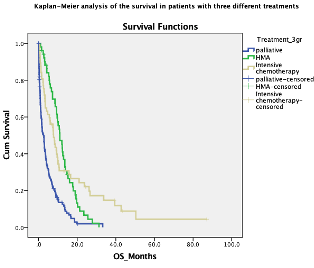
Contributions
Abstract: PB1419
Type: Publication Only
Session title: Acute myeloid leukemia - Clinical
Background
Prognosis of elderly patients with acute myeloid leukemia (AML) is dismal. Hypomethylating agents(HMAs) are recommended treatments for these patients due to their acceptable toxicity profiles and favorable efficacy. However, their high cost precludes their general use, especially in developing countries. Therefore, the fixed-dose HMAs approach was adopted in Thailand in order to reduce the expense.
Aims
This study aimed to investigate the clinical outcome of various treatment protocols including intensive chemotherapy, fixed-dose HMAs, and palliative treatment in Thai AML patients aged over 60 years. Fixed-dose HMAs included 5-azacitidine given at 100 mg per day for 7 days and decitabine given at 20 mg per day for 5 days.
Methods
We conducted a 10-year retrospective, single-center study in elderly AML patients diagnosed between January 1, 2010, and December 31, 2020. The inclusion criteria were (1) patients aged above 60 years; and (2) patients with newly diagnosed AML. The exclusion criteria were acute promyelocytic leukemia with PML-RARA.
Results
A total of 243 elderly AML patients were enrolled, with a mean age of 71± 8 years. Most of which (70%) had de novo AML. Poor risk cytogenetics was observed in the majority of cases (32.9%). The overall mortality rate was 90.9%. Median overall survival (OS) was 5 months (95% CI 3.6-6.4). Comparing a 3-group of treatment regimens (intensive chemotherapies fixed-dose HMAs and palliative treatment), the proportions of patients in each category accounted for 23.5%, 21.3%, and 55.1%, respectively. Median OS in each therapeutic option was 7.7, 11, and 2.5 months, respectively. From a multivariate analysis, palliative treatment had significantly inferior OS when compared to intensive treatment and fixed-dose HMAs (HR 0.41: 95% CI 0.28-0.61 and HR 0.42: 95% CI 0.29-0.60, respectively). Nevertheless, the OS outcome in patients with fixed-dose HMAs was comparable to those with intensive treatment (HR 0.89: 95% CI 0.57-1.38).

Conclusion
Our study confirms the poor outcome of AML in elderly patients, especially in patients receiving palliative strategy. The fixed-dose regimen of HMAs is the treatment of choice for these patients which is non-inferiority to intensive therapy.
Keyword(s): Acute myeloid leukemia, Elderly
Abstract: PB1419
Type: Publication Only
Session title: Acute myeloid leukemia - Clinical
Background
Prognosis of elderly patients with acute myeloid leukemia (AML) is dismal. Hypomethylating agents(HMAs) are recommended treatments for these patients due to their acceptable toxicity profiles and favorable efficacy. However, their high cost precludes their general use, especially in developing countries. Therefore, the fixed-dose HMAs approach was adopted in Thailand in order to reduce the expense.
Aims
This study aimed to investigate the clinical outcome of various treatment protocols including intensive chemotherapy, fixed-dose HMAs, and palliative treatment in Thai AML patients aged over 60 years. Fixed-dose HMAs included 5-azacitidine given at 100 mg per day for 7 days and decitabine given at 20 mg per day for 5 days.
Methods
We conducted a 10-year retrospective, single-center study in elderly AML patients diagnosed between January 1, 2010, and December 31, 2020. The inclusion criteria were (1) patients aged above 60 years; and (2) patients with newly diagnosed AML. The exclusion criteria were acute promyelocytic leukemia with PML-RARA.
Results
A total of 243 elderly AML patients were enrolled, with a mean age of 71± 8 years. Most of which (70%) had de novo AML. Poor risk cytogenetics was observed in the majority of cases (32.9%). The overall mortality rate was 90.9%. Median overall survival (OS) was 5 months (95% CI 3.6-6.4). Comparing a 3-group of treatment regimens (intensive chemotherapies fixed-dose HMAs and palliative treatment), the proportions of patients in each category accounted for 23.5%, 21.3%, and 55.1%, respectively. Median OS in each therapeutic option was 7.7, 11, and 2.5 months, respectively. From a multivariate analysis, palliative treatment had significantly inferior OS when compared to intensive treatment and fixed-dose HMAs (HR 0.41: 95% CI 0.28-0.61 and HR 0.42: 95% CI 0.29-0.60, respectively). Nevertheless, the OS outcome in patients with fixed-dose HMAs was comparable to those with intensive treatment (HR 0.89: 95% CI 0.57-1.38).

Conclusion
Our study confirms the poor outcome of AML in elderly patients, especially in patients receiving palliative strategy. The fixed-dose regimen of HMAs is the treatment of choice for these patients which is non-inferiority to intensive therapy.
Keyword(s): Acute myeloid leukemia, Elderly


